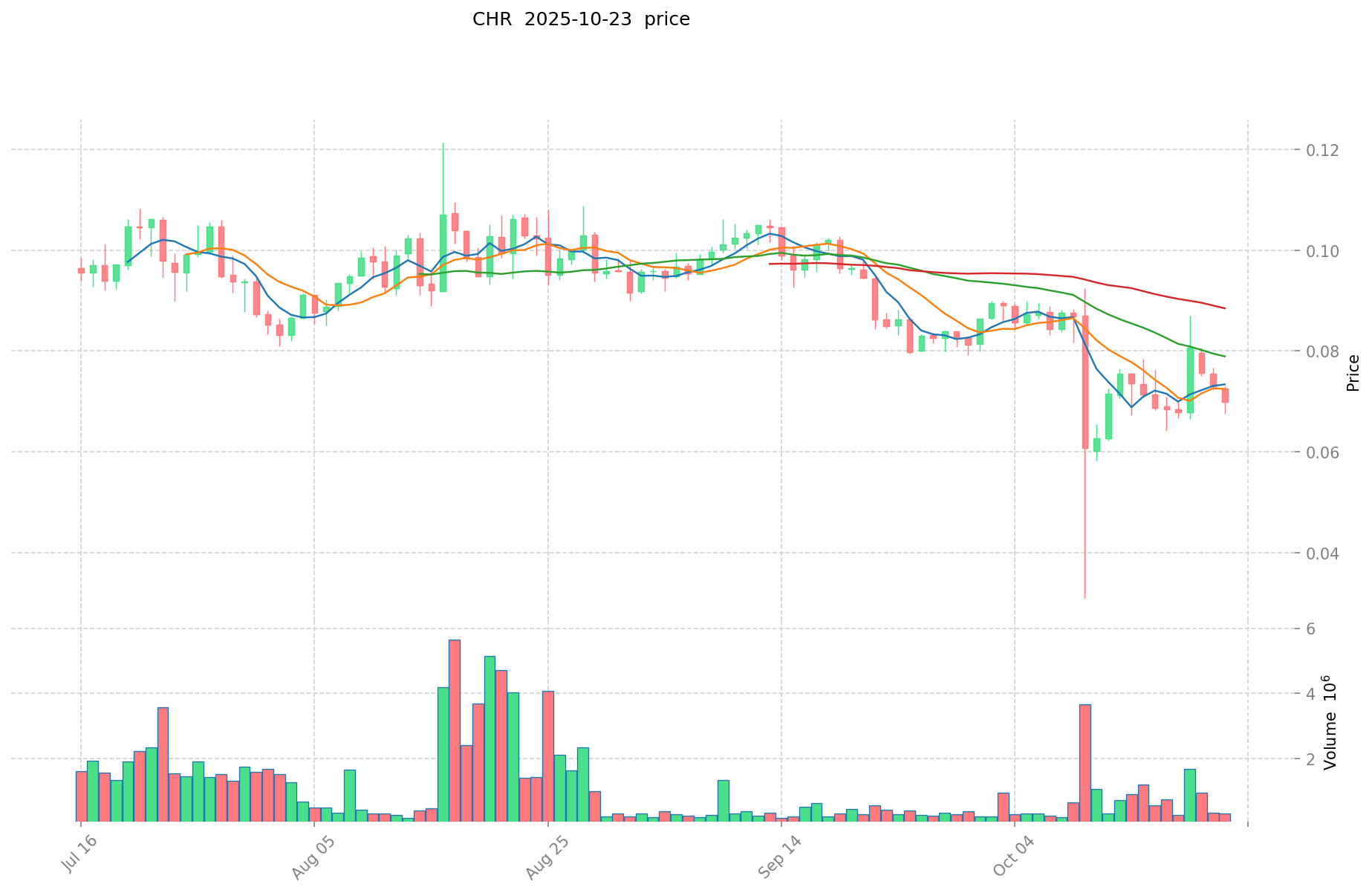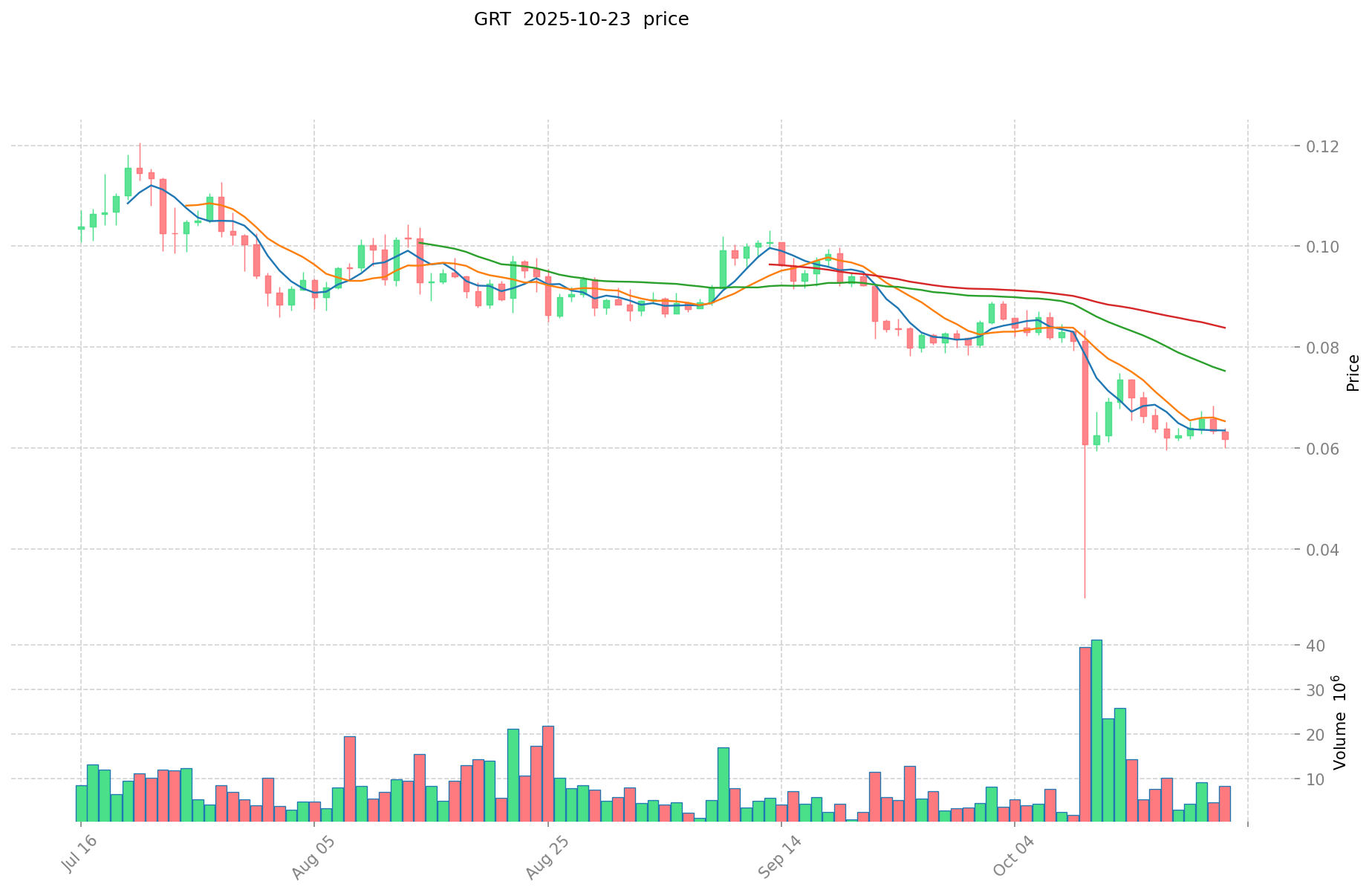CHR vs GRT: Comparing Chrome and Great Reset Theory in the Digital Age
Introduction: CHR vs GRT Investment Comparison
In the cryptocurrency market, Chromia (CHR) vs The Graph (GRT) comparison has always been a topic that investors cannot avoid. The two not only have significant differences in market cap ranking, application scenarios, and price performance, but also represent different cryptocurrency asset positions.
Chromia (CHR): Since its launch in 2019, it has gained market recognition for its innovative blockchain platform for decentralized applications.
The Graph (GRT): Introduced in 2020, it has been hailed as the "Google of blockchains" for its indexing and querying protocol for blockchain data.
This article will comprehensively analyze the investment value comparison between CHR and GRT, focusing on historical price trends, supply mechanisms, institutional adoption, technical ecosystems, and future predictions, and attempt to answer the question that investors are most concerned about:
"Which is the better buy right now?"
I. Price History Comparison and Current Market Status
CHR and GRT Historical Price Trends
- 2021: CHR reached its all-time high of $1.49 on November 20, 2021.
- 2021: GRT peaked at $2.84 on February 12, 2021, marking a significant milestone.
- Comparative analysis: During the 2021 bull market, CHR rose from $0.00874003 to $1.49, while GRT surged from its launch price of $0.03 to $2.84.
Current Market Situation (2025-10-23)
- CHR current price: $0.0698
- GRT current price: $0.06174
- 24-hour trading volume: CHR $20,863,679 vs GRT $517,613,087
- Market Sentiment Index (Fear & Greed Index): 25 (Extreme Fear)
Click to view real-time prices:
- Check CHR current price Market Price
- Check GRT current price Market Price


II. Core Factors Influencing the Investment Value of CHR vs GRT
Supply Mechanisms Comparison (Tokenomics)
- CHR: Market value affected by macroeconomic trends and regulatory policies
- GRT: Price fluctuations influenced by market demand and sentiment
- 📌 Historical Pattern: Supply mechanisms drive price cycles through investor sentiment and market regulation changes.
Institutional Adoption and Market Applications
- Institutional Holdings: Data insufficient to determine institutional preference
- Enterprise Adoption: Both tokens' exchange rates affected by technological innovation
- National Policies: Regulatory policies significantly impact both assets' valuation
Technical Development and Ecosystem Building
- CHR Technical Upgrades: Value influenced by technological innovation developments
- GRT Technical Development: Similar dependency on advancements in underlying technology
- Ecosystem Comparison: Both affected by market sentiment and broader adoption factors
Macroeconomic Factors and Market Cycles
- Performance in Inflationary Environments: Both tokens influenced by broader macroeconomic trends
- Macroeconomic Monetary Policies: Currency exchange rates with JPY, NAD, MMK, and UYU demonstrate global economic impact
- Geopolitical Factors: Investment value susceptible to changes in international market regulations
III. 2025-2030 Price Prediction: CHR vs GRT
Short-term Prediction (2025)
- CHR: Conservative $0.0586992 - $0.06988 | Optimistic $0.06988 - $0.0957356
- GRT: Conservative $0.055503 - $0.06167 | Optimistic $0.06167 - $0.0894215
Mid-term Prediction (2027)
- CHR may enter a growth phase, with prices expected in the range of $0.05793233688 - $0.1272755886
- GRT may enter a growth phase, with prices expected in the range of $0.08468678575 - $0.12747589855
- Key drivers: Institutional capital inflow, ETFs, ecosystem development
Long-term Prediction (2030)
- CHR: Base scenario $0.075064656990692 - $0.131692380685425 | Optimistic scenario $0.131692380685425 - $0.146178542560821
- GRT: Base scenario $0.116541930589667 - $0.14387892665391 | Optimistic scenario $0.14387892665391 - $0.189920183183161
Disclaimer
CHR:
| 年份 | 预测最高价 | 预测平均价格 | 预测最低价 | 涨跌幅 |
|---|---|---|---|---|
| 2025 | 0.0957356 | 0.06988 | 0.0586992 | 0 |
| 2026 | 0.092744736 | 0.0828078 | 0.059621616 | 18 |
| 2027 | 0.1272755886 | 0.087776268 | 0.05793233688 | 25 |
| 2028 | 0.13978370679 | 0.1075259283 | 0.082794964791 | 54 |
| 2029 | 0.13972994382585 | 0.123654817545 | 0.1088162394396 | 77 |
| 2030 | 0.146178542560821 | 0.131692380685425 | 0.075064656990692 | 88 |
GRT:
| 年份 | 预测最高价 | 预测平均价格 | 预测最低价 | 涨跌幅 |
|---|---|---|---|---|
| 2025 | 0.0894215 | 0.06167 | 0.055503 | 0 |
| 2026 | 0.10274222 | 0.07554575 | 0.058925685 | 22 |
| 2027 | 0.12747589855 | 0.089143985 | 0.08468678575 | 44 |
| 2028 | 0.125639532459 | 0.108309941775 | 0.08664795342 | 75 |
| 2029 | 0.17078311619082 | 0.116974737117 | 0.08422181072424 | 89 |
| 2030 | 0.189920183183161 | 0.14387892665391 | 0.116541930589667 | 133 |
IV. Investment Strategy Comparison: CHR vs GRT
Long-term vs Short-term Investment Strategies
- CHR: Suitable for investors focused on decentralized application platforms and ecosystem potential
- GRT: Suitable for investors interested in blockchain data indexing and querying infrastructure
Risk Management and Asset Allocation
- Conservative investors: CHR: 30% vs GRT: 70%
- Aggressive investors: CHR: 60% vs GRT: 40%
- Hedging tools: Stablecoin allocation, options, cross-currency combinations
V. Potential Risk Comparison
Market Risks
- CHR: Susceptible to volatility in the broader cryptocurrency market
- GRT: Exposed to fluctuations in demand for blockchain data services
Technical Risks
- CHR: Scalability, network stability
- GRT: Data indexing accuracy, potential centralization concerns
Regulatory Risks
- Global regulatory policies may impact both tokens differently, with potential for increased scrutiny on blockchain infrastructure projects
VI. Conclusion: Which Is the Better Buy?
📌 Investment Value Summary:
- CHR advantages: Innovative blockchain platform for decentralized applications, potential for ecosystem growth
- GRT advantages: Established position in blockchain data indexing, dubbed the "Google of blockchains"
✅ Investment Advice:
- New investors: Consider a balanced approach with a slight preference for GRT due to its more established market position
- Experienced investors: Explore a diversified portfolio including both CHR and GRT, adjusting based on risk tolerance and market trends
- Institutional investors: Conduct thorough due diligence on both projects, considering long-term potential and regulatory compliance
⚠️ Risk Warning: The cryptocurrency market is highly volatile, and this article does not constitute investment advice. None
VII. FAQ
Q1: What are the main differences between CHR and GRT? A: CHR is an innovative blockchain platform for decentralized applications, while GRT is known as the "Google of blockchains" for its indexing and querying protocol for blockchain data. CHR focuses on application development, while GRT specializes in data indexing and querying infrastructure.
Q2: Which token has performed better historically? A: During the 2021 bull market, CHR rose from $0.00874003 to $1.49, while GRT surged from its launch price of $0.03 to $2.84. GRT reached a higher all-time high of $2.84 compared to CHR's $1.49.
Q3: How do the current market situations of CHR and GRT compare? A: As of 2025-10-23, CHR's price is $0.0698 with a 24-hour trading volume of $20,863,679, while GRT's price is $0.06174 with a significantly higher 24-hour trading volume of $517,613,087.
Q4: What are the long-term price predictions for CHR and GRT? A: For 2030, CHR's base scenario predicts a range of $0.075064656990692 - $0.131692380685425, with an optimistic scenario of $0.131692380685425 - $0.146178542560821. GRT's base scenario for 2030 is $0.116541930589667 - $0.14387892665391, with an optimistic scenario of $0.14387892665391 - $0.189920183183161.
Q5: How should investors allocate their assets between CHR and GRT? A: Conservative investors might consider allocating 30% to CHR and 70% to GRT, while aggressive investors might opt for 60% CHR and 40% GRT. However, individual allocations should be based on personal risk tolerance and market analysis.
Q6: What are the main risks associated with investing in CHR and GRT? A: Both tokens face market risks related to cryptocurrency volatility. CHR has technical risks concerning scalability and network stability, while GRT faces risks related to data indexing accuracy and potential centralization. Both are subject to regulatory risks, which may impact blockchain infrastructure projects.
Q7: Which token is considered the better buy? A: The better buy depends on individual investment goals and risk tolerance. New investors might prefer GRT due to its more established market position, while experienced investors could consider a diversified portfolio including both. Institutional investors should conduct thorough due diligence on both projects, considering long-term potential and regulatory compliance.
Share
Content